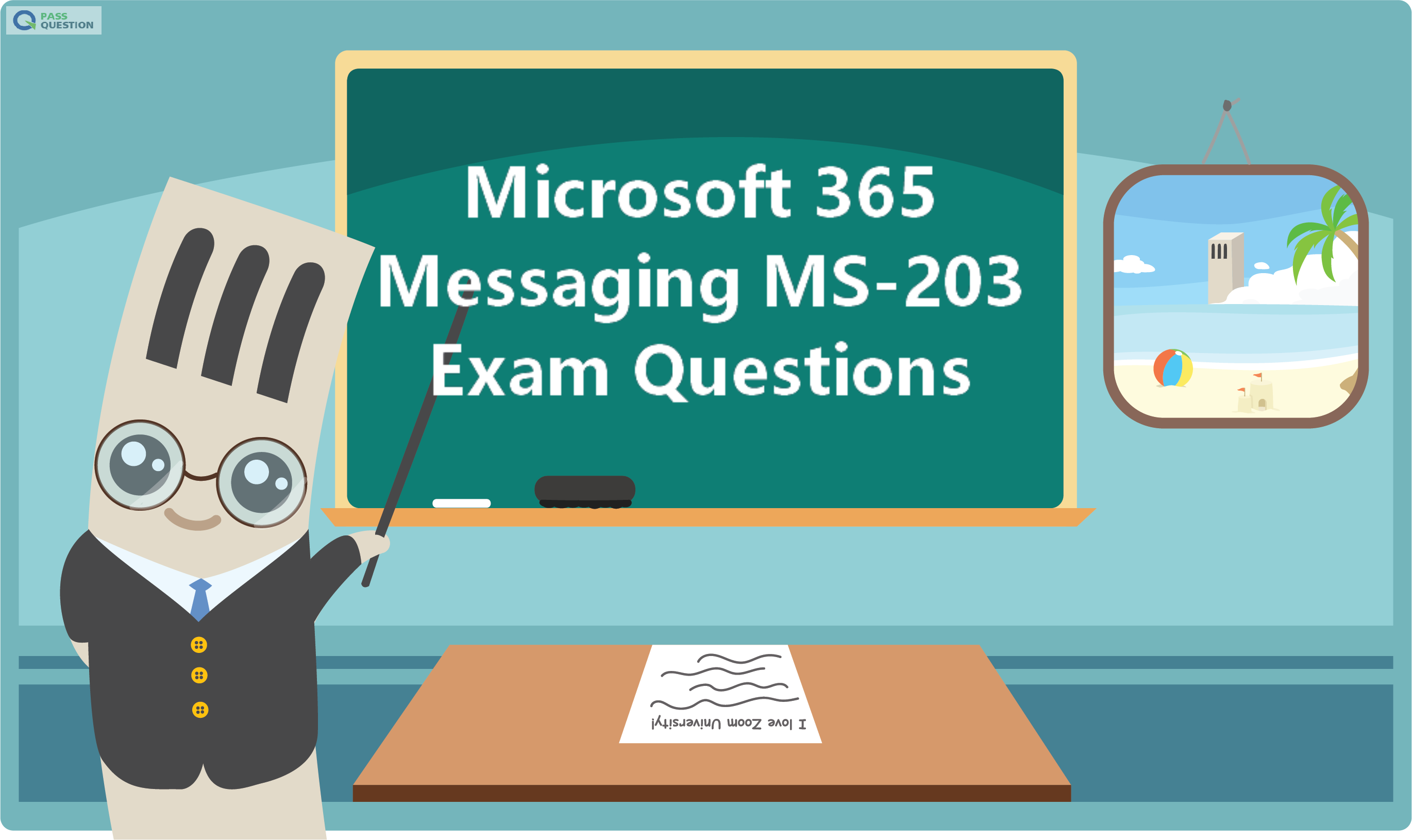Microsoft 365 Messaging MS-203 Exam Questions
MS-203 Microsoft 365 Messaging is a new single exam instead of MS-200 and MS-201 exams,you will earn Microsoft 365 Certified: Messaging Administrator Associate certification if you passed Microsoft MS-203 exam. PassQuestion provides the latest Microsoft 365 Messaging MS-203 Exam Questions which not only cover all the main and important MS-203 knowledge, but also MS-203 real questions and answers for you to practice. You are guaranteed to pass your MS-203 Microsoft 365 Messaging Exam with ease on your first attempt.

MS-203 Exam Overview - Microsoft 365 Messaging
Candidates for this exam are Messaging Administrators who deploy, configure, manage, troubleshoot, and monitor recipients, permissions, mail protection, mail flow, and public folders in hybrid and cloud enterprise environments.Messaging Administrators are responsible for managing hygiene, messaging infrastructure, hybrid configuration, migration, transport, mailboxes, and client access.
Messaging Administrators collaborate with the Security Administrator and Microsoft 365 Enterprise Administrator to implement a secure hybrid or cloud-only topology that meets the business needs of an enterprise.The Messaging Administrator should have a working knowledge of authentication types, licensing, and integration with Microsoft 365 applications.
Exam Domain Covered In MS-203 Test
Manage organizational settings and resources (30-35%)
Plan and manage the mail architecture (20-25%)
Plan and implement a hybrid configuration and migration (20-25%)
Secure the messaging environment (20-25%)
Manage Organizational Settings and Resources
Plan and manage organizational settings
- Manage Global Address List (GAL)
- Manage Offline Address Book (OAB)
- Manage address book policies
- Manage email address policies
- Configure organizational sharing
- Manage add-ins
Plan and manage client access
- Plan namespaces
- Configure virtual directories and URLs
- Configure global Outlook Web App (OWA) policies
- Configure Autodiscover
- Troubleshoot client access connectivity problems
- Manage Exchange certificates lifecycle
Manage recipient resources
- Manage archive mailboxes
- Manage resource mailboxes
- Manage groups (Distribution, Security, and Office 365)
- Manage mailboxes
- Manage mailbox permissions
- Configure mailbox policies
- Manage shared mailboxes
- Evaluate license options
- Manage mail users
Manage mobile devices
- Configure mobile device mailbox policies
- Configure mobile authentication methods
- Configure and manage Outlook mobile
- Manage mobile device access
- Configure and manage ActiveSync
Plan and Manage the Mail Architecture
Plan and configure transport architecture
- Plan connectors
- Create and configure connectors
- Configure connectors between tenants
Manage mail flow
- Manage transport rules
- Manage domains
- Manage hybrid mail flow
Troubleshoot mail flow
- Validate inbound and outbound mail flow
- Trace a message
- Analyze a message trace
- Analyze message headers
- Analyze Non-Deliverable Reports (NDRs)
- Investigate transport logs
- Nonitor Mail Flow
Plan and Implement a Hybrid Configuration and Migration
Plan and implement a hybrid environment
- Evaluate and configure hybrid free/busy access (NOT: ADFS, WAP and Not Azure AD Connect, IdFix because they belong to the Modern Desktop Admin)
- Decide between Exchange Classic Hybrid and Exchange Modern Hybrid
- Manage the Edge server role
- Configure Organization Configuration Transfer (OCT)
- Plan and configure the environment by using the Hybrid Configuration Wizard (HCW)
- Deploy the Exchange Hybrid Agent
Plan and implement migration
- Evaluate migration methods, including cutover, staged, PST Imports, IMAP, G-Suite
- Configure migration endpoints in Microsoft 365, including tenant-to-tenant
- Manage mailbox migration request batches
- Migrating from non-Microsoft messaging systems (NOT: not on-prem solutions)
- Troubleshoot mailbox migration
Manage public folders
- Move content between public folder mailboxes
- Create additional public folder mailboxes
- Implement public folder Top Level Hierarchy (TLH)
- Implement mail-enabled public folders
- Plan and configure public folders
- Manage hold and discovery for public folders
- plan a public folder migration to Microsoft 365
Secure the Messaging Environment
Manage role-based permissions
- Manage role groups
- Assign user accounts to admin roles
- Manage user roles
- Manage a delegated Role-based Access Control (RBAC) setup
- Plan RBAC roles for eDiscovery
Manage message hygiene using Exchange Online and Office 365 Advanced Threat Protection (ATP)
- Plan for message hygiene
- Manage connection filters
- Configure malware filters
- Configure spam filters
- Monitor quarantined items
- Manage protection for phishing
- Plan and configure Spam Confidence Levels (SCL)
- Configure and manage ATP safe attachments
- Configure and manage ATP safe links
- Configure and manage ATP anti-phishing
Manage compliance
- Configure retention policies
- Configure data loss prevention policies
- Configure and analyze audit logs
- Manage journal rules
- Manage content search
- Manage litigation, in-place, and retention holds
Comments
Post a Comment